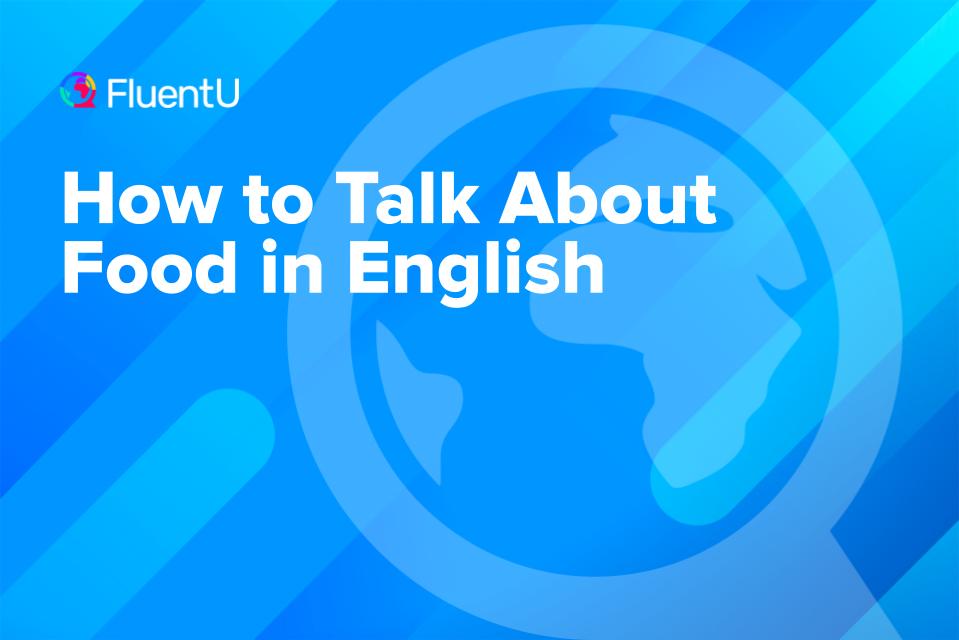Contents
- Describing Flavors and Taste
- 1. Tastes great!
- 2. Really good!
- 3. Wow, [this food] is amazing!
- 4. Yummy
- 5. Flavorful
- 6. Mouth-watering
- 7. This [food] is too [flavor] for me. / This taste is too [flavor] for my taste
- 8. It could use a little more / It could use a little less…
- 9. This tastes different. I think I prefer [something else]
- Diet Preferences
- More Common Food Words
- Chicken Preparation Styles
- Egg Cooking Methods
- And One More Thing...
How to Talk About Food in English

Food is one of the biggest topics of conversation in any language. So if you want to participate in these conversations in English, you’ll need many different descriptive English phrases and words for food and how it tastes.
Let’s look at 30 ways to talk about food in English, so you can start ordering food at restaurants, feel comfortable at dinner parties or comment on your friend’s latest Instagram food post.
You can also refer to this lesson from our YouTube channel:
Download: This blog post is available as a convenient and portable PDF that you can take anywhere. Click here to get a copy. (Download)
Describing Flavors and Taste
1. Tastes great!
Eating something delicious right now? Use this expression to say so.
I’m so glad I ordered this pizza—it tastes great!
2. Really good!
Here’s something else you could say instead of delicious.
Have you tried the chocolate cake? It’s really good!
3. Wow, [this food] is amazing!
If something tastes better than you expected, you could use the word wow to express your surprise. If you say something tastes amazing, you’re saying it tastes even better than great or really good.
Wow, this pasta salad is amazing!
4. Yummy
This is an informal way of saying something tastes good. If you find something to be delicious, you could simply say “Yummy!” or you could expand it into a sentence.
This cheesecake is really yummy. I’m going for another slice.
5. Flavorful
This is a great adjective for describing food that’s full of flavor or that has a delicious quality in its taste and smell.
I love how flavorful this soup is with all the fresh herbs and vegetables in it.
6. Mouth-watering
This is the perfect adjective to describe something that’s so delicious and flavorful, it’s actually making your mouth water.
His mom makes such mouth-watering cakes that I just can’t wait to go over to his house tonight.
There may be times when you don’t really like the taste of a certain food. But you probably can’t just shout “Yuck!” (an informal English word meaning something tastes or smells bad) without offending the cook or your hosts.
So how can you express that without sounding impolite?
7. This [food] is too [flavor] for me. / This taste is too [flavor] for my taste
This is a polite way to explain that you don’t like the food, without blaming the cook. It’s just not right for you.
Better yet if you can throw in a compliment first!
This cake is so moist! It’s just too sweet for my taste.
8. It could use a little more / It could use a little less…
Use this expression to say that you’d like the food better if the flavors were different.
This chicken is too spicy. It could use a little less chili sauce.
9. This tastes different. I think I prefer [something else]
If something tastes new or unfamiliar, you could politely name some other food that you’d prefer or like better.
This tiramisu tastes different. I think I prefer the chocolate cake.
Diet Preferences
10. Vegetarian
If you’re a vegetarian, your diet would include only vegetables, fruits and non-meat items such as tofu, nuts, etc.
I’ve been a vegetarian for a year and I don’t even miss eating meat at all.
11. Vegan
A vegan is similar to a vegetarian, however, a vegan would not eat dairy or any product from animals, like honey.
Every week, my friend and I try a new vegan recipe.
12. Flexitarian
A flexitarian does incorporate some meat into their diet, so their diet is flexible. Meat is limited, rather than excluded entirely from their diet.
While my best friend is a flexitarian, she will always choose a vegetarian option when we eat out.
13. Trying to lose weight
If you’re trying to lose weight, it means you’re trying to become thinner.
I usually just have a salad for lunch because I’m trying to lose weight.
14. Low-carb diet
The word carb is short for carbohydrate. A low-carb diet involves eating less carbohydrate-rich foods such as bread, pancakes and cookies.
That strawberry muffin looks tempting, but I’m on a low-carb diet.
15. A balanced diet
Most people simply try to keep a balanced diet, which includes eating from each of the main food groups like grains, vegetables, fruits, dairy and meat.
To stay healthy, I go to the gym, cycle to work and eat a balanced diet.
More Common Food Words
16. Fast food
Fast food is served very quickly over the counter at restaurants such as McDonald’s or Chick-fil-A. It’s usually a meal with hamburgers or sandwiches, French fries and soda.
When I’m busy with school, I usually end up eating fast food.
17. Home-cooked meal
A home-cooked meal is what many of us would like to have waiting for us when we get home from school or work. This is a fresh meal that’s made and eaten at home.
Whenever I get home early from work, I make myself a nice home-cooked meal.
18. One-pot meal
A one-pot meal means exactly what it says. You cook all of your ingredients (food items) like meat and vegetables in one pot and you’re ready to eat.
If I’m too tired to cook, I just make a quick and easy one-pot meal.
19. Microwave meal
If you’re in a rush or you want an easier meal, you might decide to eat a microwave meal—this is a pre-made meal that is cooked in the microwave.
Before he learned to cook, he used to always buy microwave meals from the grocery store.
20. Dessert
Dessert is a sweet dish, like pastry or ice cream, that’s served and eaten at the end of a meal.
21. To have a sweet tooth
Do you enjoy eating sweet food very much? Well then, you must have a sweet tooth for sure.
I’ll admit I have a sweet tooth because I can never say no to cakes, pastries and ice cream.
22. To eat healthy
Here’s an easy one. To eat healthy simply means choosing to eat food that’s good for your health.
No matter how busy I am, I try to eat healthy and exercise every day.
Chicken Preparation Styles
23. Fried or deep-fried
Fried chicken is made by cooking the meat in hot oil. Often the fried chicken we get at restaurants is actually deep-fried.
So what’s the difference between frying and deep-frying? Well, deep-frying uses a lot more oil than frying. Most times, people just say fried chicken when referring to deep-fried chicken because the word is shorter and easier to say.
I can’t think of anything I like better than fried chicken, can you?
24. Grilled
Grilled chicken is made by cooking the meat directly on a heated grill.
I think I’ll invite my friends over for some grilled chicken this weekend.
25. Roast
Roast chicken usually refers to chicken that is cooked (or roasted) in the oven.
26. Crunchy
If you deep-fry your chicken well, it’ll be crunchy, which means it’ll make a crunching, cracking sound when you bite and chew on it.
That fried chicken I had for lunch was so crunchy and yummy. I just can’t stop thinking about it.
Egg Cooking Methods
27. Scrambled
Scrambled eggs are made by stirring and mixing them together while cooking.
I usually make scrambled eggs for breakfast because they’re so easy.
28. Poached
Poached eggs are made by partially cooking the egg in simmering water. When it’s served, the egg whites will be soft and you’ll be able to see the whole yolk.
I’ve never had a poached egg but I’d sure like to try it.
29. Sunny-side up
Sunny-side up refers to an egg that’s been fried on only one side. Its name comes from the fact that the yolk sits whole in the middle of the fried egg, making it look like the sun.
The only way my son will eat eggs is if I make them sunny-side up. He likes to see the yellow yolk!
30. Boiled
Boiled eggs are eggs that have been cooked in very hot (boiling) water.
On the weekend, I usually have a boiled egg for breakfast with toast and orange juice.
One of the best ways to start learning these words is to see them in authentic English contexts. For example, you could try watching cooking videos or you could use an immersive language learning program like FluentU.
FluentU takes authentic videos—like music videos, movie trailers, news and inspiring talks—and turns them into personalized language learning lessons.
You can try FluentU for free for 2 weeks. Check out the website or download the iOS app or Android app.
P.S. Click here to take advantage of our current sale! (Expires at the end of this month.)

I hope you’ve learned some useful vocabulary here today that’ll boost your confidence before jumping into any discussion about food. Remember, the more you practice, the more natural you’ll sound. Happy learning and good luck!
For more food-related phrases, check out our post on essential English restaurant vocabulary next.
Download: This blog post is available as a convenient and portable PDF that you can take anywhere. Click here to get a copy. (Download)
And One More Thing...
If you like learning English through movies and online media, you should also check out FluentU. FluentU lets you learn English from popular talk shows, catchy music videos and funny commercials, as you can see here:
The FluentU app and website makes it really easy to watch English videos. There are captions that are interactive. That means you can tap on any word to see an image, definition, and useful examples.
For example, when you tap on the word "searching," you see this:
Learn all the vocabulary in any video with quizzes. Swipe left or right to see more examples for the word you’re learning.

FluentU helps you learn fast with useful questions and multiple examples. Learn more.
The best part? FluentU remembers the vocabulary that you’re learning. It gives you extra practice with difficult words—and reminds you when it’s time to review what you’ve learned. You have a truly personalized experience.
Start using the FluentU website on your computer or tablet or, better yet, download the FluentU app from the iTunes or Google Play store. Click here to take advantage of our current sale! (Expires at the end of this month.)










